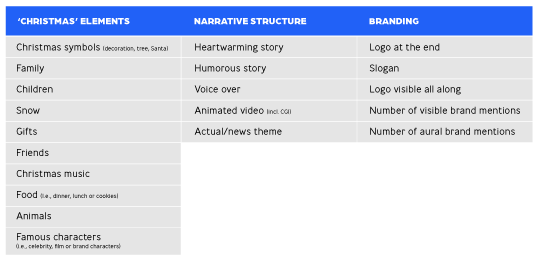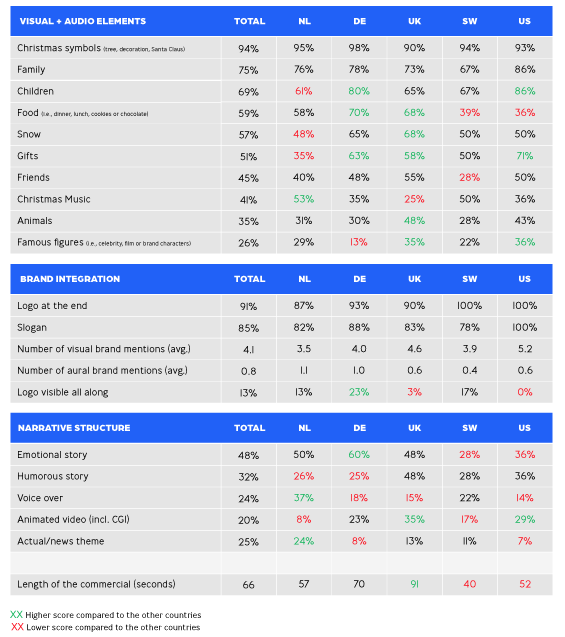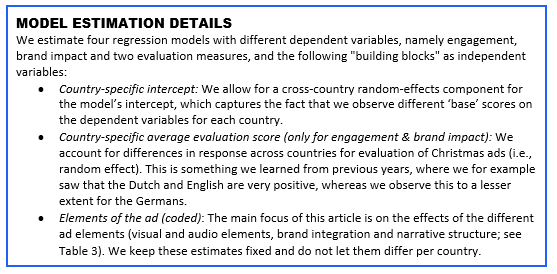Unraveling the magic recipe for Christmas ads
Gepubliceerd op 30 11 2023A meta-analysis of almost 200 Christmas ads from Europe and the US from the past 4 years
Lisette Kruizinga – de Vries
Introduction
As December is approaching, the days are becoming shorter and colder. It is that magical time of the year, there’s excitement in the air, with lights glowing and Christmas music playing everywhere. We watch our favourite Christmas movies on TV, while eating chocolate or homemade Christmas cookies, interrupted by cinematic Christmas ads – if you are still watching traditional television.
This article is not about the newest Christmas ads of this year – stay tuned for that! – but rather focuses on the ads from previous years. Looking at all the data we have gathered so far got us thinking: Wouldn’t it be great to unravel the magic recipe for the perfect Christmas ad? Imagine we would code all previously tested Christmas ads on various elements ranging from visual elements such as children, snow, food, and Christmas decorations to the type of narrative and link these elements to success factors. Shouldn’t we then be able to determine the secret ingredients and unravel the magic recipe for the perfect Christmas ad? Could it really be that simple or is there more to it?
Testing Christmas ads since 2019
Since 2019 we have been testing Christmas ads in multiple countries. In the first years we focused on our core countries (the Netherlands, UK, Germany), but last year we extended the scope to also include Sweden and the US, the origin of modern Christmas. We have tested all Christmas ads in the DVJ way by creating an ad reel with only Christmas ads that compete for the consumer’s attention in each market, and people can naturally watch each ad for as long as they want to. In this ‘unforced exposure’ methodology people can skip the ads (for example, by zapping or getting something to drink) as they would when they watch TV at home. We then ask respondents what they remember seeing in terms of the brand and the ad’s message, and finally, we show each respondent two ads in full length and let them evaluate their creativity.
Up until now, we have tested 174 Christmas ads in four years, among different countries spanning Europe and the US (see Table 1). Each year, each respondent evaluated two ads in total, and with a minimum of 100 respondents per ad, the total number of respondents reached nearly 18,000.
Table 1: Number of ads per country

Coding the ads
After collecting all those ads, we coded them on different elements that could potentially explain different outcome measures and that enabled us to determine what elements ‘the perfect Christmas ad’ should contain. We started with the most obvious visual and aural elements that are related to Christmas and celebrating Christmas – Christmas trees and decorations, friends, family, snow, food, and Christmas music.
We also looked at the narrative structure and coded whether the ad is more emotional or humorous and whether it makes references to actuality (for example, to COVID-19 or poverty). We also considered the animation and voiceover of the video as additional factors. Of course, we also coded whether the logo is visible throughout the ad, the number of brand mentions both visually and aurally, and whether a slogan is included.
See Table 2 for a full overview of the elements we coded the ads on. The ads are coded by four independent coders, and any unclarities or mismatches in the coding were discussed with the four coders after which they came to a final coding of all elements for all ads.
Table 2: Coding of elements per ad

people love Christmas commercials
Before diving into the results from this meta-analysis, let’s start with some learnings from previous years. We all know that during Christmas time, many brands compete for the attention of the consumer, and each year it is a competition in which the ad will be declared the winner of the most emotional, beautiful, or funniest commercial of the year, especially in the United Kingdom. Previous years taught us 3 important things:
- Christmas commercials are rated more positively than regular commercials, mainly in the Netherlands and the UK.
- Brand recall measures for Christmas commercials are typically relatively low.
- Christmas commercials often have lower brand fit and understanding.
So, while Christmas commercials are highly relevant, positively evaluated, and generate attention, they do not always pay off for the brand because brand fit and linkage are weak, and brand recall lags. Another drawback is that the ad often contains a key message that can only be understood and comprehended after watching until the end. However, this is an unrealistic scenario, as most consumers won’t do that.
Now, let’s dive a bit deeper into the elements that are used in the Christmas ads that can potentially explain these results.
snow, kids, emotions – what is not missed in Christmas ads?
Table 3 below shows how often different audio and visual elements are included in ads across European countries and the US. To no surprise for us all, Christmas symbols like Christmas trees, decorations and Santa Claus are almost always (94%) used in Christmas commercials. Among the top 5 most often used visual elements belong also family (75%), children (69%), food (59%), and snow (57%).
Interestingly, we can observe some differences across countries. To name a few, food appears in fewer Christmas commercials in Sweden (39%) and the United States (36%), compared to the other countries. Gifts are also used less frequently in the Netherlands (35%), where there is not a strong tradition of gift-giving during Christmas. Probably related to that, children appear more often in German (80%) and US (86%) Christmas commercials than in ads from other countries. Gifts are most often given to children, and this tradition is the strongest in Germany and the US.
Table 3: Occurrence of visual & audio elements, brand integration & narrative structure

Another striking thing is that almost all Christmas ads end with a logo (91%) and slogan (85%), whereas a logo visible throughout the commercial is rarely used (13%). In order to prioritise creating visually appealing commercials with minimal branding throughout the ad, brands choose to display the brand at the very end. Taking into account what we have learned in previous years, it is questionable whether this is a smart thing to do.
Moving on to the occurrence of the ad´s narrative structure, we observe that on average about 50% of all Christmas ads are heartwarming and emotional. This occurs relatively more in Germany (60%) and relatively less in Sweden (28%) and the US (36%). In the UK, humorous ads (48%) are more often running on TV. A voice-over is commonly used in the Netherlands as well as a link to an actual theme. Only 20% of all tested Christmas ads are animated, but we see these more often in the British (35%) and the US (29%) market. Finally, the UK has by far the longest commercials (on average 91 seconds compared to the total average of 66 seconds). This can be related to the long tradition of Christmas ads and the fact that people are eagerly awaiting new Christmas ads. British ads are released in the first half of November, which is way earlier than in the other countries.
Model estimation
Now, we want to examine how these different elements of the Christmas ads can be linked to their success factors, which are engagement, brand impact and evaluation. For engagement, we look at the average time someone spends watching the ad (average duration), and for brand impact, we evaluate unaided brand recall, which is an important recall measure for brands but often falls behind for Christmas ads. Finally, in terms of evaluation, we focus on two measures: excitement (because Christmas ads are often exciting) and brand fit (which is also a measure that frequently falls behind, so knowing how to improve it is helpful).
As for explanatory variables, we include all coded elements, except for a few that are too often being used in Christmas ads and therefore show little variation in the data. Those are Christmas symbols, the logo at the end, and the slogan. One element that is too little used is the logo visible all along. We used a cut-off for determining which elements to include by adding those elements that have relative occurrences ranging from 15% to 75% to be still able to determine the effects. We also add the length of the commercial as a control variable.
We estimate different so-called mixed models, whereby we estimate fixed and random effects. As we know from prior years and pre-testing in general, metrics and scores differ between countries. We can account for these score discrepancies among countries by calculating random effects. See the quadrant with ‘model estimation details’ for further information on model estimation.

Secrets of Festive Fun: What Drives Engagement, Brand impact, and evaluation of Christmas Ads?
Table 4 shows the model estimation results of the fixed effects. To keep the table readable, the random effects for the intercept and the average ad evaluation are not shown in the table, but we observe interesting differences across countries, which are worth discussing. For example, the intercept for engagement ranges from 59 for the Netherlands – of which we know that respondents zap away quickly – to 83 in Germany and Sweden, countries where respondents zap away much less. Likewise, for excitement, the estimates range from 34 in the Netherlands to 48 in the US.
Table 4: Model estimation results

Unaided brand recall is higher for ads that show food and friends. Also, when the ad is evaluated more positively, unaided brand recall is higher, which could be caused by respondents watching the ad with more focus when the ad is better. Famous figures, which also include brand characters, enhance brand recall, which is expected as brand characters can easily be linked to the brand. On the other hand, an animated video decreases unaided brand recall. In the animated videos, there is generally a nice story being told, with generally less clear references to the brand.
And what about evaluation? What are elements that make people rate the ad higher on different evaluation metrics? Commercials that contain children, snow, gifts, and an emotional story get higher excitement scores. Voiceover is negatively related to excitement. For brand fit, we see similar elements, namely, ads that contain animals, children, gifts, Christmas music, and famous figures, and that are animated show higher brand fit. Again, famous figures are also brand characters and we noticed that some brands go for an animated video each year, which therefore might benefit the brand fit. Finally, the number of visual brand mentions in the ad enhances brand fit too.
These are merely numbers and abstract findings, so let’s bring them to life with a few examples.
bringing the insights to life with some examples
In the following section, we will focus on some examples of ads that perform well. As average duration was the most difficult metric to be explained, and we do not have those clear indicators on which knobs to turn, we focus the examples on ads that perform well on unaided brand recall, excitement and brand fit.
Jumbo
The commercial from the Jumbo supermarket in the Netherlands (2021) is one of the best when it comes to unaided brand recall. First of all, it starts in the supermarket itself, which has a very clear look & feel which is directly recognisable. In addition to that, the Jumbo brand is visible during the whole commercial and the family that is at the centre of the commercial is the family that always appears in commercials of Jumbo. Hence, this family can be considered a ‘brand character’ and they are famous actors from the Netherlands as well. At the same time, it’s expressing a light-hearted story humorously, while pointing out that for the first year after the covid pandemic, people could enjoy Christmas together again – and then emphasising this fact by inviting everyone they know for Christmas.
Figure 1: Example Christmas commercial Jumbo NL 2021
 DISNEY
DISNEY
The second example comes from Disney (2022), which scored high on both excitement and brand fit. It tells a short story about a little girl. Soon, her entire world is about to change as a brother or sister (’the gift’) will enter her life. Of course, Disney is famous for their animated stories, and what they did was keep the visuals of the commercial the same for each country, just as they do for their films, but change both the text and the lyrics to the local language and have a local artist sing it.
We have tested this ad in five countries and for all countries it scores very well (best or Top20) on excitement as well as on brand fit. Only in the Netherlands and the UK, the ad score for excitement is a bit above the Christmas benchmark (but it still scores above Top20 for the general TV benchmark for the Netherlands and on Top40 for the UK). It has many elements that are positively related to excitement, namely children, snow, gifts and of course the emotional, heart-warming story.
Figure 2: Example Christmas commercial Disney 2022

Kroger
Another exemplary Christmas ad that scores well on both excitement and brand fit is from Kroger in the US (2022). Brand impact measures for this ad fall a bit behind, which could be explained by the fact that the brand is shown briefly on paper grocery bags and again in the very last shot. It tells the story of a grandpa, who finds the old recipe book of his deceased wife. He decides to make the recipes and relive the moments he had during his life together with his wife. In the end, his daughter is visiting for Christmas together with her family and Grandpa shares the Turkish roast. The recipes stay alive and in the family. The ad is very sentimental and emotional but very nicely executed.
Figure 3: Example Christmas commercial Kroger US 2022

Finally, let us share a few ads that show high brand fit scores, which shouldn’t surprise anyone, as they stay very close to what they stand for as a brand and what they are known for. We are speaking of relatively short ads from Dr Oetker and M&Ms.
Dr. Oetker
Dr. Oetker is a traditional baking brand that originated in Germany and the Christmas commercial focuses on different people baking different things while using Dr. Oetker’s baking products. Baking for special occasions has a very strong tradition in Germany and the ad cleverly showcases its baking products in use while the brand logo is visible all along. Very functional and very clear, which is what the brand stands for. Interestingly, they had a similar ad in the Netherlands, but the Dutch ad focused more on the baking mixes instead of the baking powders, as the Dutch are more convenient whereas the Germans do not consider using a baking mix as baking something yourself. (Writer´s note: “I experienced myself as a Dutchie living in Germany for a couple of years.”)
Figure 4: Example Christmas commercial Dr. Oetker Germany 2022

M&Ms
The M&M commercial, which we only tested in the US, as always features the M&M’s, which are very recognisable making the brand instantly visible. Another brand fit characteristic present in the ad is that it is not too serious and tells a short funny story.
Figure 5: Example Christmas commercial M&M’s US 2022

M&S Food
Finally – finishing with a bang! – with a strong UK commercial from M&S Food that scored also especially high on brand fit. It stars a little fairy who has already been in their commercials for several years – and again this year – making it a strong brand character. As to their standard, the ad is telling a nice story about a fictive friend that the fairy brings to life. Of course, food cannot be missed and hence is at the centre of the ad. It is perceived as highly distinctive for the brand, easy to understand, funny and relevant.
Figure 6: Example Christmas commercial M&S Food UK 2022

conclusions
In this study, we looked at many Christmas ads from previous years to find the magic recipe for the perfect Christmas ad. We analysed commercials from Europe and the US, searching for elements that enhance engagement, brand impact and ad evaluation. We found that different factors only partly explain why some ads are successful. The differences we saw between countries also play a big role in how ads perform. Thankfully, how the single elements are combined and how the story is being told (i.e., the creative execution) is extremely important. So, in the end, we couldn’t unravel the magic recipe for the perfect Christmas ad.
Stay tuned for our next articles where we will test multiple 2023 Christmas ads for different countries. Which ad will be performing best? Will the best-scoring ad for brand recall contain brand characters? And will the best-scoring ad regarding evaluation contain children, gifts or famous figures? Or will it be something else, and will an ad with a magic ingredient win? We will see!